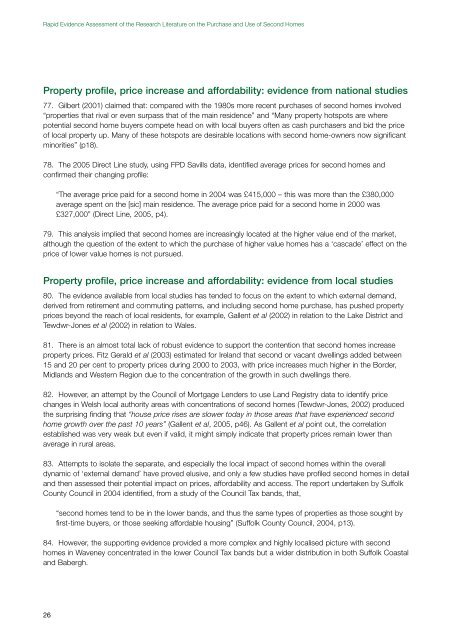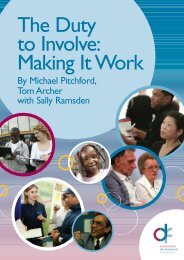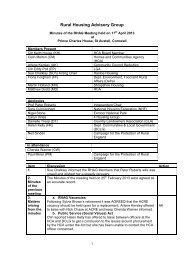Rapid Evidence Assessment of the Research ... - Rural Housing
Rapid Evidence Assessment of the Research ... - Rural Housing
Rapid Evidence Assessment of the Research ... - Rural Housing
Create successful ePaper yourself
Turn your PDF publications into a flip-book with our unique Google optimized e-Paper software.
<strong>Rapid</strong> <strong>Evidence</strong> <strong>Assessment</strong> <strong>of</strong> <strong>the</strong> <strong>Research</strong> Literature on <strong>the</strong> Purchase and Use <strong>of</strong> Second Homes<br />
Property pr<strong>of</strong>ile, price increase and affordability: evidence from national studies<br />
77. Gilbert (2001) claimed that: compared with <strong>the</strong> 1980s more recent purchases <strong>of</strong> second homes involved<br />
“properties that rival or even surpass that <strong>of</strong> <strong>the</strong> main residence” and “Many property hotspots are where<br />
potential second home buyers compete head on with local buyers <strong>of</strong>ten as cash purchasers and bid <strong>the</strong> price<br />
<strong>of</strong> local property up. Many <strong>of</strong> <strong>the</strong>se hotspots are desirable locations with second home-owners now significant<br />
minorities” (p18).<br />
78. The 2005 Direct Line study, using FPD Savills data, identified average prices for second homes and<br />
confirmed <strong>the</strong>ir changing pr<strong>of</strong>ile:<br />
26<br />
“The average price paid for a second home in 2004 was £415,000 – this was more than <strong>the</strong> £380,000<br />
average spent on <strong>the</strong> [sic] main residence. The average price paid for a second home in 2000 was<br />
£327,000” (Direct Line, 2005, p4).<br />
79. This analysis implied that second homes are increasingly located at <strong>the</strong> higher value end <strong>of</strong> <strong>the</strong> market,<br />
although <strong>the</strong> question <strong>of</strong> <strong>the</strong> extent to which <strong>the</strong> purchase <strong>of</strong> higher value homes has a ‘cascade’ effect on <strong>the</strong><br />
price <strong>of</strong> lower value homes is not pursued.<br />
Property pr<strong>of</strong>ile, price increase and affordability: evidence from local studies<br />
80. The evidence available from local studies has tended to focus on <strong>the</strong> extent to which external demand,<br />
derived from retirement and commuting patterns, and including second home purchase, has pushed property<br />
prices beyond <strong>the</strong> reach <strong>of</strong> local residents, for example, Gallent et al (2002) in relation to <strong>the</strong> Lake District and<br />
Tewdwr-Jones et al (2002) in relation to Wales.<br />
81. There is an almost total lack <strong>of</strong> robust evidence to support <strong>the</strong> contention that second homes increase<br />
property prices. Fitz Gerald et al (2003) estimated for Ireland that second or vacant dwellings added between<br />
15 and 20 per cent to property prices during 2000 to 2003, with price increases much higher in <strong>the</strong> Border,<br />
Midlands and Western Region due to <strong>the</strong> concentration <strong>of</strong> <strong>the</strong> growth in such dwellings <strong>the</strong>re.<br />
82. However, an attempt by <strong>the</strong> Council <strong>of</strong> Mortgage Lenders to use Land Registry data to identify price<br />
changes in Welsh local authority areas with concentrations <strong>of</strong> second homes (Tewdwr-Jones, 2002) produced<br />
<strong>the</strong> surprising finding that “house price rises are slower today in those areas that have experienced second<br />
home growth over <strong>the</strong> past 10 years” (Gallent et al, 2005, p46). As Gallent et al point out, <strong>the</strong> correlation<br />
established was very weak but even if valid, it might simply indicate that property prices remain lower than<br />
average in rural areas.<br />
83. Attempts to isolate <strong>the</strong> separate, and especially <strong>the</strong> local impact <strong>of</strong> second homes within <strong>the</strong> overall<br />
dynamic <strong>of</strong> ‘external demand’ have proved elusive, and only a few studies have pr<strong>of</strong>iled second homes in detail<br />
and <strong>the</strong>n assessed <strong>the</strong>ir potential impact on prices, affordability and access. The report undertaken by Suffolk<br />
County Council in 2004 identified, from a study <strong>of</strong> <strong>the</strong> Council Tax bands, that,<br />
“second homes tend to be in <strong>the</strong> lower bands, and thus <strong>the</strong> same types <strong>of</strong> properties as those sought by<br />
first-time buyers, or those seeking affordable housing” (Suffolk County Council, 2004, p13).<br />
84. However, <strong>the</strong> supporting evidence provided a more complex and highly localised picture with second<br />
homes in Waveney concentrated in <strong>the</strong> lower Council Tax bands but a wider distribution in both Suffolk Coastal<br />
and Babergh.






